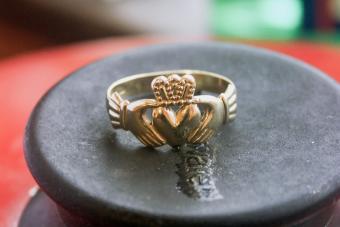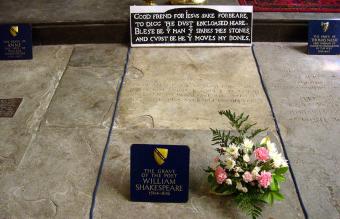
In many cultures, symbolism is significant to families. Different symbols signify various emotions or aspects of heritage and life that are honored and carried on through the generations. The Celtic people have numerous symbols in their culture, many of which represent family. These Celtic symbols for family highlight the love and importance this group for people have for its kin.
Irish Harp Symbol: Family Pride
The harp is a traditional Celtic symbol prevalent throughout Ireland as it is on the official state seal. The Irish Harp symbolizes one's immortal soul and holds deep meaning for Christian families. It symbolizes that life on earth is not the end, but there is eternal life after passing on from this world. Once banned because of its connection to the Irish resistance against England's rule, it is now a significant piece of Celtic heritage, and families look to it is as a symbol of national pride.

Claddagh Ring: Foundational Family Attributes
Story says the first Claddagh Ring was created in the fishing village of Claddagh, Galway, hence the ring's present name. The Claddagh symbol contains a heart held by two hands, with a crown atop the heart. Claddagh rings are used as friendship, engagement, and wedding rings and represent friendship (the hands), love (the heart), and loyalty (the crown). These attributes are ones used to describe clans or families and make excellent family symbols and heirlooms.

Celtic Cross: Family Faith and Heritage Symbol
According to Symbol Dictionary, the Celtic Cross originated as a way for Druids to worship Taranis, a Gallic sun god. The original symbol was a solar wheel. However, when the Celtic people converted to Christianity, they kept the wheel and converted it by adding a cross to reflect their new religious beliefs. The symbol ties faith to heritage and signifies the knowledge, strength, and compassion needed to manage the ups and downs in life, something most families can relate to.

Serch Bythol: A Symbol of Love That Grows
The Serch Bythol symbol is a lesser-known Celtic Symbol that highlights how in touch the Celts were with their emotions and relationships. It symbolizes true and eternal love between two people. This love becomes the foundation on which families are built.

Attribution-Non Derivatives 4.0 International (CC BY-ND 4.0) Created by LoveToKnow Serch Bythol Symbol of Love
Crest: Celtic Family Symbol
Those who hail from Ireland may want to search for their family crest. A typical family crest represents the family name (or surname) and often contains an image of an animal. Traditionally, these crests were worn by the men in the family. The crest commonly represented what the family was known for, where they hailed from, and who supported that family. Family crests are precious to many Celts, symbolizing their heritage, lineage, and familial history.

Family Coat of Arms: Individual Symbol of Familial Values
Irish families also designed their own Coat of Arms that included the family crest. Some family members even had their own Coat of Arms and Crest. The Coat of Arms includes the family heraldic badge, the family crest, and a torse (wreath). Each of these components gets chosen with great care as they specifically represent the core family values.

Celtic Torc Symbols: Family and Rank
The Celtic Torc was a twisted gold necklace worn choker-style. It is thought that the adornment symbolized one's power and strength, but also their rank within their clan and their clan's rank within the higher order. Celtic Torc necklaces and bracelets have been traced back to the Viking Age and are still worn by Celts today to highlight devotion to the family and power within the family.

Celtic Knots: The Tie That Binds
There are several designs of Celtic knots, and each has a different meaning. According to What's Your Sign, there is minimal written history about Celtic knots. The meanings and stories behind them have been passed down orally over the years, making it difficult to decipher the true meaning. Probably, the best guess is that each knot has a special meaning for a specific family. For example, the Triquetra, which is also known as a trinity knot, is thought to stand for one of the following:
- Christian trinity (Father, Son, and Holy Spirit)
- Pagan trio (Mother, Crone, and Maiden)
- Mind, body, and spirit

IrishCentral explains families look for Celtic symbols to represent their family, such as a family tattoo. The website suggests the Ogham sign is an ideal symbol for family and the power of family love. The interweaving designs of Celtic knots are perfect representations of how families are interconnected and how their lives are intertwined.
Welsh Love Spoons: Symbols of Love
A love spoon was simply a wooden spoon decorated with symbols and given to a romantic interest. The symbols created the meaning behind each spoon. For example, a chain symbolized a wish to be together with that person forever, a heart signified love, and a lock meant "I will look after you."

Besides being a declaration of love, the love spoon was a visual demonstration of the suitor's woodworking skills and proof to the bride's father that he could provide for the man's daughter. Beyond that, he was capable of taking care of the family their union would one day create. This type of love spoon usually presented entwined hearts and bells as Celtic symbols of the marriage and union of two people. Besides being symbolic of the family itself, the spoons often depicted the dreams and hopes for a future family. The carving of balls inside cages or indentations represented how many children the groom wished to create from the couple's union.

Celtic Tree of Life: Roots and Wings
Many cultures around the world use trees to symbolize values and meaning. In the Celtic culture, the Tree of Life, or the Crann Bethadh, balance and harmony, both of which are key attributes to healthy family living. One can also look at the Tree of Life and acknowledge the obvious roots and outstretched leaves, drawing parallels to family members who go off on their own but remain rooted in their family.

Ancient Celtic Symbols and Their Deeper Meanings as Family Signs
Ancient Celtic symbols often had more than one meaning and held deep family significance for the Celts. Today, this tradition lives on with those of Celtic descent. They don jewelry, celebrate family ties with tattoos, and keep artwork symbolizing their heritage and the special meaning each sign holds for their families.







